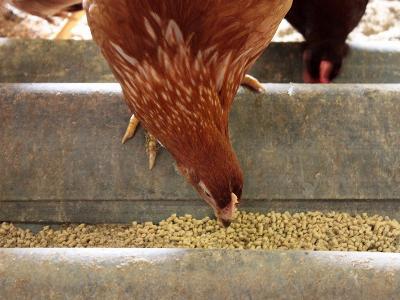New developments in layer hen feeding

Ioannis Mavromichalis, Ph.D., gives his views on poultry, pig and dairy nutrition based on his experience as a nutrition consultant with clients around the world.
Photo by Andrea Gantz
A new method has been proposed that adapts the normal behavior of the hen to the requirements of modern farming.
A single diet offered during the early hours of the light period with some source of calcium top-dresses during the afternoon is the standard feeding program for layers worldwide. Yet a new method has been proposed that adapts the normal behavior of the hen to the requirements of modern farming. This method, called split feeding, is based on the principle that two feeds can be offered, one in the morning and another in the afternoon, at different quantities and with different nutrient composition. The morning feed focuses on the protein and energy requirements of the hen, whereas the afternoon feed focuses on the calcium requirement that coincides with eggshell formation.
In preliminary studies, hens in split-feeding regimens consumed slightly less nutrients and eggshell quality remained strong or improved. Thus, not only was normal feeding behavior allowed, but profitability increased if we discount the extra cost of logistics for the second feed. This reduction in nutrient intake can have further positive consequences in terms of reduced nitrogen and phosphorus excretion and less stress on the hen coming from the excessive consumption of calcium needed to sustain eggshell quality, especially during the late laying period.
Of course, this system remains in the experimental stage as more work is needed to verify and fine-tune the details of each feed, but it appears to be a promising development. In addition, the logistics of the second feed currently prohibit the incorporation of this novel method into most existing facilities, but this is something that can be resolved, or included, in the design of new facilities. Nevertheless, it is something that requires attention.
For more information, the read the relevant proceedings from the 2016 Poultry Federation Conference.
Ioannis Mavromichalis, Ph.D., is Nutrition Editor for WATTAgNet and Editor-in-Chief of Pig International
Có thể bạn quan tâm
 New broiler breeders feed recommendations developed
New broiler breeders feed recommendations developed As a result, broiler breeders are increasingly suffering from feed and nutrient restrictions that are detrimental to their welfare and have a negative impact on
 South Korea: Hybrid breed securing chicken success
South Korea: Hybrid breed securing chicken success A hybrid breed of chicken known as ‘Samgye’, is increasing in popularity in South Korea and boosting the success of the poultry industry in the country
 Europe, Asia, Africa on heightened alert for avian flu
Europe, Asia, Africa on heightened alert for avian flu Poultry flocks in 9 European countries have been affected. South Korea, Japan, Israel and Iran have also reported new outbreaks on poultry farms the last week
 New developments in layer hen feeding
New developments in layer hen feeding Ioannis Mavromichalis, Ph.D., gives his views on poultry, pig and dairy nutrition based on his experience as a nutrition consultant with clients around the worl
 Warning for US egg producers: Beware of free-range hens
Warning for US egg producers: Beware of free-range hens John Campbell, chairman of Glenrath Farms, counsels that U.S. egg producers should work to keep the U.S. egg market from going to free-range.